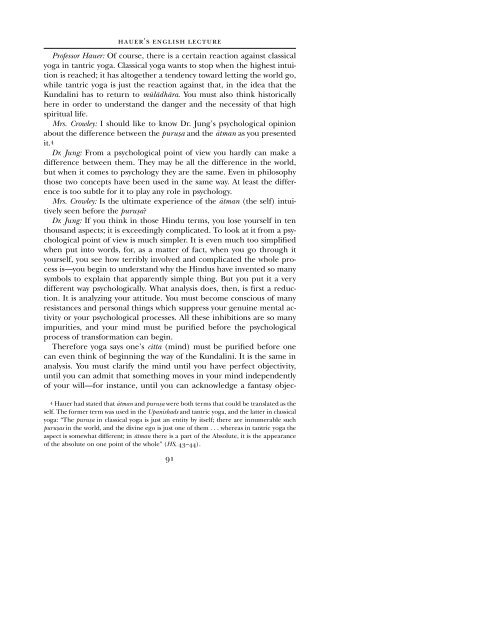CG JUNG - Countryside Anarchist
CG JUNG - Countryside Anarchist
CG JUNG - Countryside Anarchist
Create successful ePaper yourself
Turn your PDF publications into a flip-book with our unique Google optimized e-Paper software.
HAUER'S ENGLISH LECTURE<br />
Professor Hauer: Of course, there is a certain reaction against classical<br />
yoga in tantric yoga. Classical yoga wants to stop when the highest intuition<br />
is reached; it has altogether a tendency toward letting the world go,<br />
while tantric yoga is just the reaction against that, in the idea that the<br />
Kundalini has to return to mÖlvdhvra. You must also think historically<br />
here in order to understand the danger and the necessity of that high<br />
spiritual life.<br />
Mrs. Crowley: I should like to know Dr. Jung’s psychological opinion<br />
about the difference between the puruüa and the vtman as you presented<br />
it. 4<br />
Dr. Jung: From a psychological point of view you hardly can make a<br />
difference between them. They may be all the difference in the world,<br />
but when it comes to psychology they are the same. Even in philosophy<br />
those two concepts have been used in the same way. At least the difference<br />
is too subtle for it to play any role in psychology.<br />
Mrs. Crowley: Is the ultimate experience of the vtman (the self) intuitively<br />
seen before the puruüa?<br />
Dr. Jung: If you think in those Hindu terms, you lose yourself in ten<br />
thousand aspects; it is exceedingly complicated. To look at it from a psychological<br />
point of view is much simpler. It is even much too simplified<br />
when put into words, for, as a matter of fact, when you go through it<br />
yourself, you see how terribly involved and complicated the whole process<br />
is—you begin to understand why the Hindus have invented so many<br />
symbols to explain that apparently simple thing. But you put it a very<br />
different way psychologically. What analysis does, then, is first a reduction.<br />
It is analyzing your attitude. You must become conscious of many<br />
resistances and personal things which suppress your genuine mental activity<br />
or your psychological processes. All these inhibitions are so many<br />
impurities, and your mind must be purified before the psychological<br />
process of transformation can begin.<br />
Therefore yoga says one’s citta (mind) must be purified before one<br />
can even think of beginning the way of the Kundalini. It is the same in<br />
analysis. You must clarify the mind until you have perfect objectivity,<br />
until you can admit that something moves in your mind independently<br />
of your will—for instance, until you can acknowledge a fantasy objec-<br />
4 Hauer had stated that vtman and puruüa were both terms that could be translated as the<br />
self. The former term was used in the Upanishads and tantric yoga, and the latter in classical<br />
yoga: “The puruüa in classical yoga is just an entity by itself; there are innumerable such<br />
puruüas in the world, and the divine ego is just one of them . . . whereas in tantric yoga the<br />
aspect is somewhat different; in vtman there is a part of the Absolute, it is the appearance<br />
of the absolute on one point of the whole” (HS, 43–44).<br />
91


